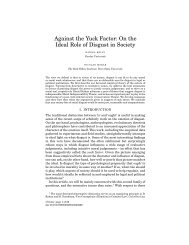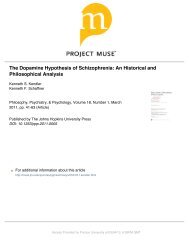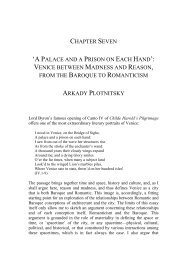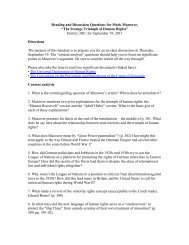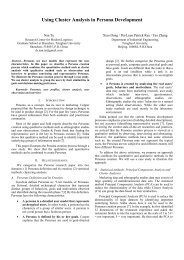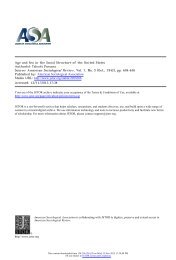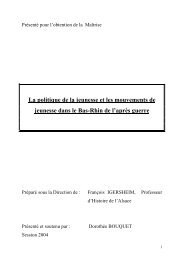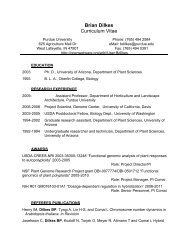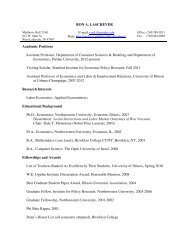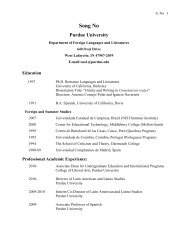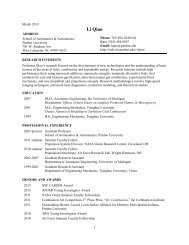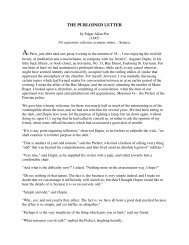Lexical Semantics of Adjectives - CiteSeerX
Lexical Semantics of Adjectives - CiteSeerX
Lexical Semantics of Adjectives - CiteSeerX
You also want an ePaper? Increase the reach of your titles
YUMPU automatically turns print PDFs into web optimized ePapers that Google loves.
19<br />
in the literature: the degrees <strong>of</strong> comparison <strong>of</strong> the gradable adjectives is the dominant one; the concept<br />
<strong>of</strong> the scale is the other issue, and it will prove to be more pertinent to our work.<br />
A sticky issue for some formal semanticists (see, for instance, Hoepelman 1983), the degrees <strong>of</strong><br />
comparison have been looked at, somewhat inconclusively, from the point <strong>of</strong> view <strong>of</strong> their relations<br />
with presuppositions (Kiefer 1978) and classified at length on quasi-logical principles<br />
(Rusiecki 1985). The morphology and syntax <strong>of</strong> comparative adjectives are typically researched<br />
more than their semantics--see, for instance, Lees (1961), Bolinger (1967b, 1972), Grundt (1970),<br />
Ultan (1972), Bresnan (1973), Hankamer (1973), Gnutzman (1974), Boguslawski (1975), Cygan<br />
(1975), Topolinska (1975), Entich (1975), Kamp (1975), Rivara 1975, Post 1981, Klein 1982,<br />
Pinkham 1982, Noailly 1993).<br />
The meaning <strong>of</strong> the positive, noncomparative adjective, such as good and big, in its relation to its<br />
comparative degree has been puzzled over--at least since Sapir wrote in a seminal essay, “It is very<br />
important to realize that psychologically all comparatives are primary in relation to their corresponding<br />
absolutes (‘positives’)” (1944: 125). Lyons forcefully supports this thesis: “Rather less<br />
obvious is the fact that the use <strong>of</strong> a gradable antonym always involves grading, implicitly if not<br />
explicitly. This was stressed by Sapir (1944), who seems to have been the first linguist to employ<br />
the term ‘grading’ in this sense” (Lyons 1977: 273-274), and, Lyons points out, “[t]he point Sapir<br />
was making is well known to logicians and goes back at least as far as Aristotle (cf. Categories 56)”<br />
(op.cit: 274, fn. 4). This thesis suggests the analysis <strong>of</strong> a positive adjective tall in (31i) as (31ii):<br />
(31) (i) John is a tall man.<br />
(ii) John is taller than an average man.<br />
Following Sapir again, Lyons (1977: 270-272) makes a popular distinction between two major<br />
kinds <strong>of</strong> scales involved in the meaning <strong>of</strong> the gradable adjectives: the continuous scale, such as<br />
good/bad, corresponding to the gradable antonyms, that he calls the “contraries,” and the discreet,<br />
bipolar scale, such as dead/alive, corresponding to the complementary antonyms that he calls the<br />
“contradictories”--cf. the discussion in Section 1.4 above <strong>of</strong> Levi’s (9ii) and the references there as<br />
well as Kiefer (1978), Gross et al. (1989). Scales have been <strong>of</strong>ten mentioned, at least casually, in<br />
the literature on adjectives--see, for instance, Aarts (1976, especially 41-42), Rivara (1993). They<br />
play an important part in Miller’s and his associates’ view <strong>of</strong> the adjectives as dominated by antonym<br />
pairs and their synonyms, a vision that lies in the foundation <strong>of</strong> their valuable online resource<br />
WordNet--see, for instance, Miller et al. (1988), Charles and Miller (1989), Gross et al. (1989),<br />
Miller and Fellbaum (1991), Beckwith et al. (1991).<br />
An interesting property <strong>of</strong> some scales is their asymmetry--see Sapir (1944: 132-133), Bierwisch<br />
(1967). Rusiecki’s (1985: 7) example <strong>of</strong> asymmetry is the dry/wet scale, with the dry end <strong>of</strong> it<br />
bound, as it were, and the wet end open: one can get wetter and wetter and one cannot achieve absolute<br />
wetness but one can achieve absolute dryness 3 . Somewhat related to the asymmetry is the<br />
category <strong>of</strong> the markedness/unmarkedness <strong>of</strong> antonyms--see, for instance, Bierwisch (1967),<br />
Givón (1984), Rusiecki (1985), Miller and Fellbaum (1991). Thus, in the long/short pair <strong>of</strong> gradable<br />
antonyms, long is unmarked (and short is marked) by the fact, according to Miller and Fellbaum<br />
(1991: 212-213)--and Bierwisch (1967)--that one can say (32i) but not (32ii)--at least, not in<br />
the same meaning:<br />
3 Again, more so in language than in reality.



